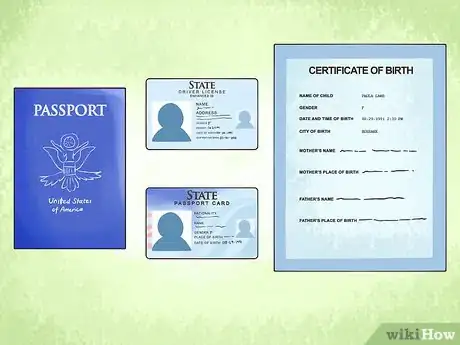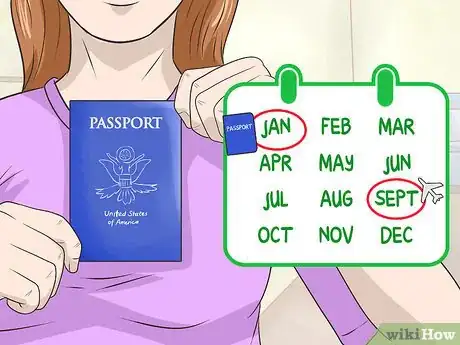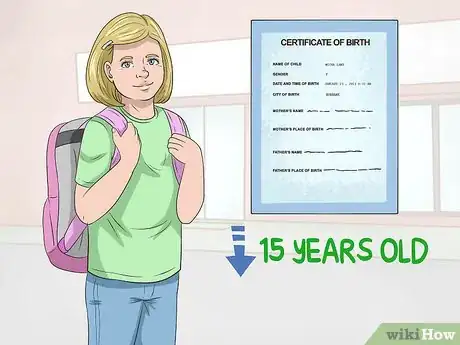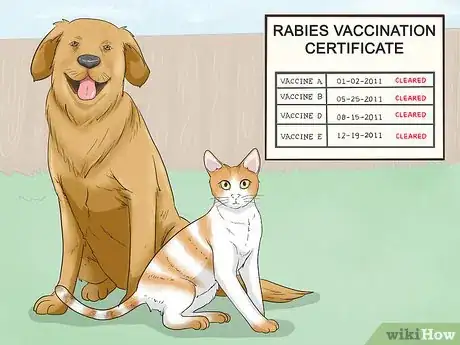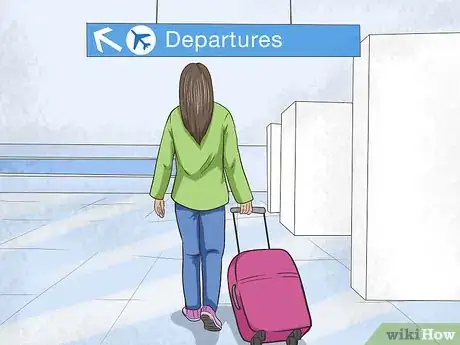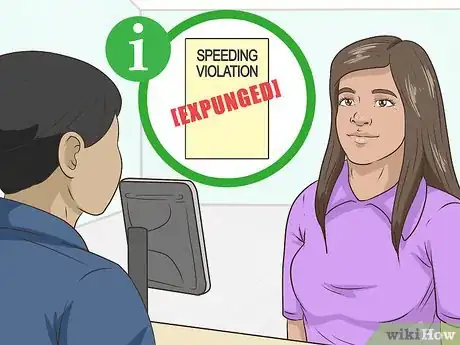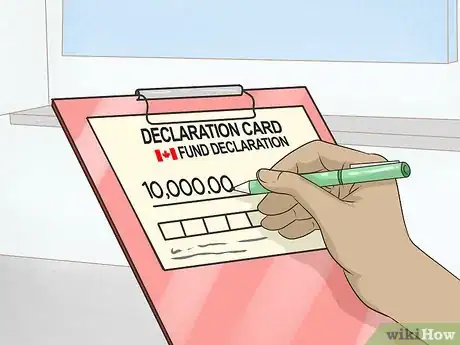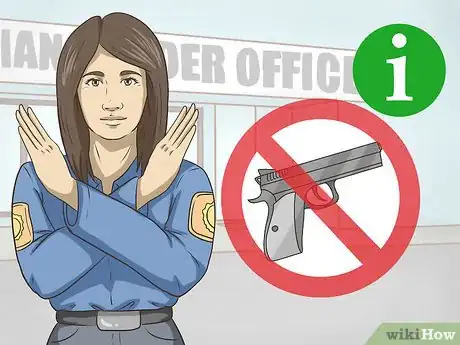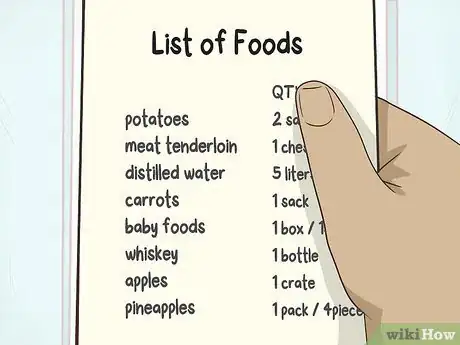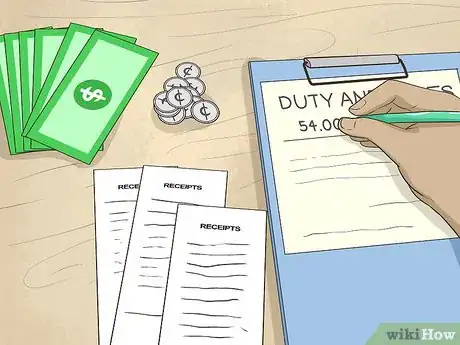This article was co-authored by Clinton M. Sandvick, JD, PhD and by wikiHow staff writer, Amber Crain. Clinton M. Sandvick worked as a civil litigator in California for over 7 years. He received his JD from the University of Wisconsin-Madison in 1998 and his PhD in American History from the University of Oregon in 2013.
There are 9 references cited in this article, which can be found at the bottom of the page.
This article has been viewed 88,987 times.
The Canada-United States border, also known as the International Boundary, is the longest international border in the world. When driving across the Canadian border from the United States, all travellers are required to go through checkpoints that are policed by border patrol officers. This process can be stressful, but you'll have a smooth experience when crossing the border if you prepare in advance and know what to expect.
Steps
Obtaining Required Identification and Documentation
-
1Meet the ID requirements.[1] All citizens of the United States aged 16 years and older must travel with a passport, passport card, Enhanced Driver’s License or Enhanced ID Card (EDL/ID) to meet requirements for crossing the border to and from Canada.[2]
- Bring proof of citizenship (like a birth certificate) in case you are asked for additional documentation.
- Permanent residents of Canada or the U.S. need to bring their Permanent Resident Cards.[3]
- International travelers who are not citizens of the United States or Canada are required to have a passport and possibly a visa when entering Canada. Find out from your home country if a visa will be required.
-
2Apply for a passport early. In anticipation of passport processing times, apply for your passport several months before your trip. Passport applications can be completed online and printed, or you can obtain one from a United States post office that has passport acceptance services.[4]
- If you need to expedite your passport, you can request and pay for a faster application processing service.
- You can only complete your passport application online and then print it out for submission. You currently cannot apply for a passport online.
Advertisement -
3Bring a birth certificate if you are traveling with a minor. Children aged 15 years or younger can cross by presenting proof of citizenship, such as a U.S. birth certificate, without a photo ID. The same goes for children aged 16-18 years old who are traveling with an organized school or other youth group (including religious youth groups).[5]
- Valid proofs of citizenship for minors are a U.S. birth certificate (original, photocopy, or certified copy), a U.S. consular report of birth abroad, and a Certificate of U.S. Naturalization.
- Children (under 18) traveling without both parents should carry a parental consent letter. Ideally, this letter should be notarized.
-
4Obtain a rabies vaccination certificate if you are traveling with your pet. Dogs and cats that are older than three months will need signed and dated rabies vaccination certificates from a veterinarian. These certificates are usually valid for 1-3 years after obtaining them.
- Service dogs are exempt from these rules as long as they are accompanied by their owners.
- The rules about crossing with pets other than cats and dogs vary. Contact CFIA for details prior to your trip.[6]
Meeting Other Basic Requirements
-
1Bring enough money for your stay. The Canada Border Services Agency (CBSA) can deny you entry if they have a reason to doubt your ability to support yourself or your dependents while you are in Canada.[7] You can reduce these financial doubts by carrying specific documents with you when crossing the border:
- Proof of finances (i.e. bank statements);
- Income tax records (past and present);
- Evidence of current employment (i.e. pay stubs, an employment ID, notarized letter from your employer);
-
2Bring evidence that you will leave Canada at the end of your visit. You may be asked to provide evidence that you have responsibilities that will guarantee your return to your home country. Examples of these responsibilities are having a permanent job, home, financial assets or family in your home country. Documents that will serve this purpose are:
- Proof of current residence, including recent proof of rent payments, copies of your mortgage and utility bills;
- Proof of your planned departure from Canada (i.e. an airline or other travel ticket that states the time and date you plan to leave);
- Information about where you plan to go while in Canada, including but not limited to the address, telephone number, and which Canadian citizen you are visiting (if applicable).
-
3Exercise caution if you have been previously convicted of a crime.[8] If you have even one criminal conviction in your past, regardless of how trivial or long ago, you can be turned away by the border officer. Civil traffic violations (such as speeding tickets) and other minor infractions (such as parking violations or littering fines) are exempted.
- DUI and DWI offenses that may be considered misdemeanors in the Unites States are considered serious offenses in Canada and you can be denied entry for them.
- If you’ve been convicted of a felony in the past, you will be prevented entry into Canada unless you've received a pardon, been accepted for rehabilitation and deemed rehabilitated.[9]
- Individuals with a past criminal conviction are allowed to cross the border as long as conviction has been expunged, but make sure you have paperwork or a letter from an attorney on hand to prove it.
-
4Be in good health. This will be determined on-site simply by observing how you look when you cross the border. If you are observed to be in a condition that is likely to endanger public health and safety, or if it will cause you to over-utilize Canada’s health or social services, you will be considered inadmissible on health grounds.[10]
Declaring Your Items
-
1Disclose your funds. There is no limit to how much money you can bring into or take out of Canada. However, if you are carrying more than $10,000 USD (or the equivalent in foreign currency), you will need to declare that to the border officer upon crossing.
- The penalties for non-compliance can be severe and very expensive.
- Travelers' checks and money orders that exceed that limit must also be declared.[11]
-
2Avoid bringing firearms. Canada’s firearm laws are very different than those of the Unites States. If you must bring them, declare and provide documentation for them to the border officer. Failure to declare them will result in seizure of the firearms and possibly even criminal charges.[12]
- If you are carrying a weapon that is illegal in Canada, it will be seized at the border. Most weapons, including tasers, will not be allowed to enter Canada.
- Expect additional delays and inspections if you bring firearms.
-
3Declare any meats, fruits, vegetables, plants, animals or animal products. By law, these items must be declared before you cross the border. This includes products that are made from plant or animal matter.
-
4Bring extra money for duty and taxes. The CBSA collects duty and taxes on imported goods. These fees can vary wildly from product to product, so the best course of action is to consult the Canada Border Service Agency’s website for information. They also provide a Duty and Taxes Estimator that you can use so that you will know what to expect when you get to the border.
- Small children and infants are entitled to a personal exemption as long as a parent or guardian can make a declaration to the CBSA for a child. The goods you are declaring must be for the child's use.
- Have your purchases and your receipts readily available when you attempt to cross the border and expect to be asked questions about them.
Warnings
- Unless you absolutely have to bring them, plan to leave your weapons and firearms behind before crossing the border. These items are highly regulated and often illegal to bring into Canada. Bringing them may cause you to be denied entry at a border point and the items could be confiscated.⧼thumbs_response⧽
- Do not attempt to cross the border with illicit drugs of any kind, including marijuana. The drugs will be confiscated and you could be fined or jailed.⧼thumbs_response⧽
References
- ↑ http://www.cbsa-asfc.gc.ca/travel-voyage/td-dv-eng.html#_s1
- ↑ https://www.dhs.gov/enhanced-drivers-licenses-what-are-they
- ↑ http://www.cbsa-asfc.gc.ca/travel-voyage/td-dv-eng.html#_s1
- ↑ https://www.usps.com/international/passports.htm
- ↑ http://www.cbsa-asfc.gc.ca/travel-voyage/td-dv-eng.html#_s1
- ↑ http://www.inspection.gc.ca/animals/terrestrial-animals/imports/policies/live-animals/pets/eng/1326600389775/1326600500578
- ↑ http://www.cic.gc.ca/english/information/inadmissibility/who.asp
- ↑ http://www.cic.gc.ca/english/information/inadmissibility/who.asp
- ↑ http://www.cic.gc.ca/english/information/inadmissibility/conviction.asp
About This Article
To cross the Canadian border, have your passport, passport card, Enhanced Driver’s License, or Enhanced ID Card available for inspection. Additionally, carry enough money to cover any duties or taxes imposed at the border, as well as living expenses while you’re in the country. Avoid bringing firearms across the border, since that requires a lot of extra paperwork, and make sure you declare any food or animal products you’re transporting. You should also be prepared to provide evidence of your plans to leave Canada, which authorities may request. For information from our Legal reviewer on how to cross the Canadian border if you’re traveling with children or pets, read on!
